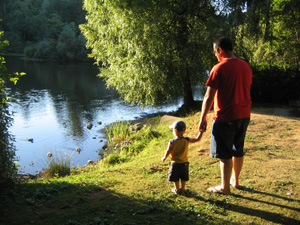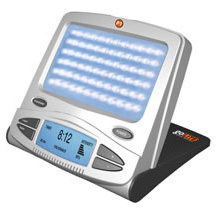"Light Box Seasonal Disorder Therapy For Depression?"
"Did you know that light affects depression?"
In the early 80’s, specialized bright light box seasonal disorder therapy (20 times brighter than normal indoor light) was discovered by researchers to be the most effective treatment for winter depression. Now tests are confirming that this box light therapy is effective for non-seasonal depression as well.
Well, I guess so!
“My most precious memory, that I often return to when the weather outside is terrible during the winter months, is a holiday I spent on the white sandy beaches in the Carribean in January one year.”

Since the beginning of time, people have realized the healing power of light. We feel refreshed when we’re in sunshine, and we wilt in the dark. Therefore, light box seasonal disorder therapy is a powerful step to cure depression.
Light actually produces hormones and neurotransmitters that affect our mood and well being. One of these hormones, serotonin, is thought to be a major factor in depression. One recent study that was reprinted in The Lancet, showed that bright light significantly increased serotonin levels, while dark or cloudy days caused serotonin to plummet.
Dozens of clinical, placebo controlled studies have been done using light box seasonal disorder therapy to treat depression. These studies confirm that box light box seasonal disorder therapy is not only as effective as other methods, but it causes no long-term side effects.

Additionally, people responded within a week to light box seasonal disorder therapy instead of several weeks with medications. Several studies have documented the advantage of specialized light box seasonal disorder therapy for depression.
Patients responded to light within a week verses several weeks for medication, and light posed no long-term negative side effects.
A review of light box seasonal disorder therapy in Archives of General Psychiatry concluded the following: “The evidence is in that light is an active neurobiological agent. Light therapy is easy to administer in outpatient settings, lacks major side effects, and, importantly, is cost-effective.” - Archives of General Psychiatry, October 1998
Doctor’s recommend that people get at least 30 minutes of bright light exposure per day. (The brain needs 2,500 lux for 30 to 60 minutes per day.) You can actually go outside in the sun or get light exposure from a special light box that emits the same amount of light (10,000 lux). This is perfect for those of you who work the night shifts or under fluorescent lights all day or live in an area of the world suffering from lack of natural sunlight.
You will find that a good light box costs no less than $170. (We think this isn’t that big a cash wad considering the amount we used to spend on our medication every month!)
You should try to get light exposure at the same time every day. Some people like to sit by it while they eat breakfast and read the paper. Some like to sit by it while they read or study in the evening. Experiment to see what works best for you. And don’t miss a day of light exposure if you can help it. This is something that will only work for you if you are consistent!
"Light Box Seasonal Disorder Therapy Devices by Apollo Health"
Apollo Health is a company which participates in published research regarding light box seasonal disorder therapy and subjects its products to stringent safety evaluation. Apollo Health has been building their light boxes for more than two decades.
For many years, the world's leading light box seasonal disorder therapy researchers and doctors have known that full-spectrum, 10,000 lux light boxes can be very effective at treating seasonal affective disorder and other related mood disorders.
Recently, researchers have discovered that a very specific range of blue light is the most effective color (wavelength) in treating these disorders. Apollo Health has spent the last several years working with leading experts to develop a new product based on this research, called the GoLite P1. This product delivers effective wavelengths, which means a more convenient treatment, and fewer side effects than traditional 10,000 lux full-spectrum light box seasonal disorder therapy devices.
Apollo Health’s Bluewave Technology is the result of ten years of research with medical universities and the National Institutes of Health (NIH). Apollo Health actually participated in this research and is the only company that we know of to produce light box seasonal disorder therapy devices that provide 100% of the effective blue light.
Used at NASA & by Research Experts
Apollo Health’s Bluewave technology has also been used at NASA as the preferred method to regulate astronaut's and shuttle crew's sleep/wake schedules.
Technology of the Future
Bluewave is so significant because it provides a higher effective response than most full spectrum light at 1/10th the intensity 10,000-lux. (This means Bluewave light box seasonal disorder therapy is not only convenient but easier on the eyes with fewer side effects.)
More Good News!
Bluewave light box seasonal disorder therapy is also approved by an FDA optical safety review.
Remember if altering a person’s behaviour will produce the same beneficial brain changes that can come from medication—without the risks and side effects—then the advantages are obvious.
Talk to your doctor about whether or not light box seasonal disorder therapy could be right for you!
Where to find Apollow Light Therapy
Related Articles
"Where Do You Begin With Box Light Therapy?"
Report on 6 Essential Ingredients to Cure Your Depression
Back to Home from Light Box Seasonal Disorder Therapy
Source:
Department Of Psychology, 426 Fraser Hall, 1415 Jayhawk Blvd., University of Kansas, Lawrence, KS 66045-7556
Light Produces Brain Serotonin / The Lancet / Low serotonin levels are associated with depression and seasonal affective disorder (SAD). Researchers provide evidence that brain serotonin levels increase when exposed to bright light. This suggests that daily light therapy has a sound basis in biology. http://www.apollolight.com/pdf_files/Direct%20brain%20serotonin%20validates%20SAD.pdf
Light Treatment for Nonseasonal Depression: Speed, Efficacy, and Combined TreatmentThe Journal of Affective Disorders / Daniel F. Kripke / Bright light can be combined with standard therapies for treating nonseasonal depressions and appears synergistic http://www.apollolight.com/pdf_files/Kripke%20NonSeasonal%20Depression.pdf

